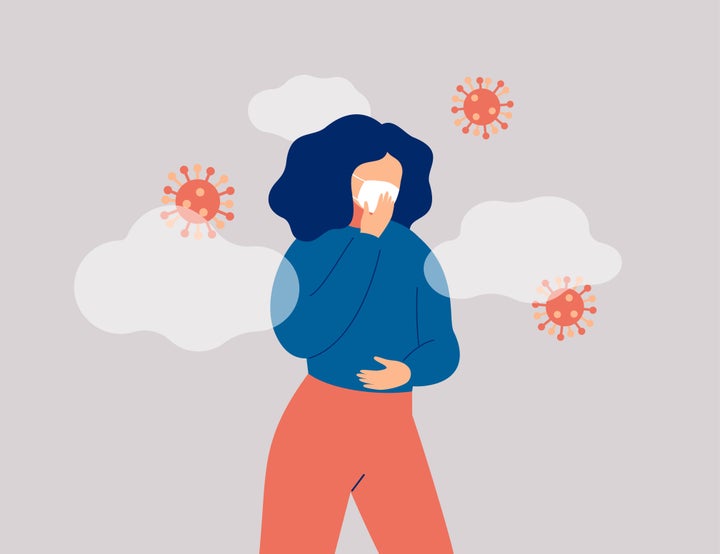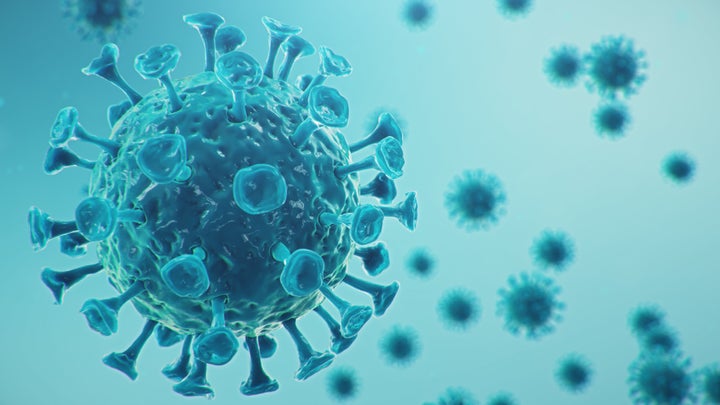It’s long been suspected that the virus that causes Covid-19 could survive in aerosol droplets – tiny particles that linger in the air long after we talk, cough or sneeze – and then infect other people when they breathe them in.
If the virus is living in the air – and potentially travelling distances to infect people – it would be considered “airborne”. This is quite a big deal, as it shifts the measures we use to try and prevent the virus from spreading.
Is Covid-19 airborne?
Airborne transmission is defined by the World Health Organisation (WHO) as the spread of an infectious agent caused by the dissemination of aerosols that remain infectious when suspended in air over long distances and time.
In official circles, SARS-CoV-2 has not yet been confirmed as airborne. However there appears to be growing consensus among some scientists that it is. In July, 239 scientists penned an open letter to WHO warning against underestimating the possibility of airborne transmission.
WHO agrees airborne transmission of the virus can occur during medical procedures that generate aerosols – for example, intubating a Covid-19 patient. But it’s in the process of evaluating whether SARS-CoV-2 may also spread through aerosols in other places, such as indoor settings with poor ventilation. It said the matter of it being airborne “cannot be ruled out”.
Some studies have shown the virus can linger in the air for up to three hours. But one of the major caveats of such studies is that the aerosols are generated using high-powered jet nebulisers under controlled laboratory conditions – this doesn’t reflect normal human cough conditions.
Recently, the US Centers for Disease Control and Prevention (CDC) posted an update on its website acknowledging the virus that causes Covid-19 could be airborne, but U-turned a few days later. The CDC said a draft version of proposed changes had been “posted in error”.

Can I catch Covid-19 from aerosols?
Modelling of SARS-CoV-2 transmission in confined spaces, published in the journal Physics of Fluids, suggests that while it isn’t without it’s risks, the chances of catching Covid-19 from aerosols are probably pretty low.
Doctors at the University of Amsterdam’s Van der Waals-Zeeman Institute used laser technology to measure the distribution of droplets released when people speak or cough. Test subjects spoke or coughed into a laser beam, and a jet nozzle was used to mimic tiny aerosol micro-droplets. Researchers then measured how droplets spread and how likely they are to pass along the virus.
While the lingering micro-droplets aren’t risk-free, due to their small size, they contain less virus than the larger droplets produced when someone coughs, speaks, or sneezes directly on us, said Daniel Bonn, one of the authors.
If someone enters a space even a few minutes after a mildly symptomatic carrier of the coronavirus has coughed in that area, the probability of infection is “rather low,” said researchers, and it’s even lower if that person was only talking.
Bonn said the findings suggest aerosol-wise that it’s “relatively safe” to go into well-ventilated modern buildings, such as airports, train stations and offices, as “modern ventilation makes the aerosol infection risk not very large”.

Commenting on the study, Dr Julian Tang, a consultant virologist at Leicester Royal Infirmary, points out that there are studies involving influenza virus that suggest smaller aerosolised particles can carry more virus than larger droplets per unit volume.
“The study does not exclude aerosol transmission,” he adds, “but I think there are too many assumptions to interpret this further to say that it is, or is not, predominant nor efficient as a route of transmission of Covid-19.”
Professor Ashley Woodcock, who works in respiratory medicine at the University of Manchester, is convinced aerosols don’t play a part in Covid-19 transmission. “I’m not a modeller,” he tells HuffPost UK. “I’m a respiratory doctor, I’m an academic, and I’m completely convinced that aerosols are irrelevant.”
Prof Woodcock says viruses like measles and chickenpox, which are spread in aerosols, have a far higher R0 value than coronavirus. The R0 value of measles is 12-18, while the R0 value of coronavirus is around 2.63. The higher the R0 value, the more infectious a virus is considered to be.
“Secondly, in confined spaces like aeroplanes, there have been virtually no cases of transmission,” he says. The International Air Transport Association (IATA) has identified 44 Covid-19 cases linked to flights since the beginning of 2020, out of roughly 1.2 billion passengers who travelled during that time. It’s worth noting however that planes do have very effective filtration systems.
He believes the main way the virus is spreading is through surface contact and that there needs to be a bigger focus on washing hands; not touching faces; and cleaning homes, schools, shops and hospitals.
How can I stay safe?
If you’re worried about exposure to the virus from air droplets, aerosol scientists in the US have made a series of recommendations on how to stay safer indoors. The main message is to avoid, or reduce as much as possible, situations that would mean you’re inhaling exhaled air from other people.
This means avoiding crowded spaces; practising social distancing; avoiding low ventilation environments and long durations in such places; avoiding places where people don’t wear masks; avoiding loud talking, shouting and singing; and avoiding places where there are high breathing rates (the scientists use indoor aerobic exercise as an example).

Once a virus escapes into the air inside a building, you have two options, said Professor Shelly Miller, an expert in mechanical engineering at the University of Colorado Boulder: you either bring in fresh air from outside or remove the virus from the air inside the building.
The safest indoor space is one that constantly has outdoor air replacing stale indoor air, she said. So, a space where windows and doors are open, or where heating, ventilating and air-conditioning (HVAC) systems are in operation. “In any room, the more people inside, the faster the air should be replaced,” she wrote in a piece for The Conversation.
In the United States, the CDC recommends air purifiers as a preventative measure for Covid-19, stating “when used properly, air purifiers can help reduce airborne contaminants, including viruses, in a home or confined space”.
Not all air purifiers are created equal, though, and scientists advise keeping an eye out for filter effectiveness – High Efficiency Particulate Air (HEPA) filters can remove most particle sizes from the air, but it’s not a failsafe solution.
Professor Woodcock believes we’re missing a trick by not focusing on the route of exposure that comes from touching surfaces and then touching our faces. He wants to see more of a spotlight on the importance of keeping areas clean.
“You could have a Get Britain Clean campaign,” he says, “everybody scrubs their houses, their hands, their children, the schools – and you just need squeezy detergent.”